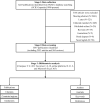Emerging trends and research foci of neuromyelitis optica spectrum disorder: a 20-year bibliometric analysis
- PMID: 37346048
- PMCID: PMC10281505
- DOI: 10.3389/fimmu.2023.1177127
Emerging trends and research foci of neuromyelitis optica spectrum disorder: a 20-year bibliometric analysis
Abstract
Background: Neuromyelitis optica spectrum disorder (NMOSD) is a demyelinating syndrome of the central nervous system. A tremendous amount of literature on NMOSD has been published. This study aimed to perform a bibliometric analysis of the publications on NMOSD and show its hotspots and development trends.
Methods: We used the Web of Science Core Collection as a database and searched the literature published between 2002 and 2022. CiteSpace, VOSviewer, online bibliometric platform, and R-bibliometrix were used to conduct bibliometric analysis and network visualization, including the number of publications, citations, countries/regions, institutions, journals, authors, references, and keywords.
Results: A total of 3,057 publications on NMOSD were published in 198 journals by 200 authors at 200 institutions from 93 countries/regions. The United States published the most literature and made great contributions to this field. The Mayo Clinic was the institution with the largest number of publications. The journal with the most publications was Multiple Sclerosis and Related Disorders, and the most co-cited journal was Neurology. The author with the most publications was Fujihara, K., while the most frequently co-cited author was Wingerchuk, DM. The current research hotspots may be focused on "efficacy," "multicenter," "interleukin-6 receptor blockade," "safety," "azathioprine," "tolerance," and "adult".
Conclusion: This study was the first bibliometric analysis of publications on the NMOSD field, visualizing its bibliometric characteristics and gaining insight into the direction, hotspots, and development of global NMOSD research, which may provide helpful information for researchers. Future research hotspots might be conducting randomized controlled trials on targeted immunotherapy in the NMOSD field.
Keywords: Citespace; NMOSD; VOSviewer; bibliometric; neuromyelitis optica spectrum disorder.
Copyright © 2023 Su, Ruan, Li, Li and Chang.
Conflict of interest statement
The authors declare that the research was conducted in the absence of any commercial or financial relationships that could be construed as a potential conflict of interest.
Figures









Similar articles
-
Research hotspots and trends on neuromyelitis optica spectrum disorders: insights from bibliometric analysis.Front Immunol. 2023 Jul 13;14:1135061. doi: 10.3389/fimmu.2023.1135061. eCollection 2023. Front Immunol. 2023. PMID: 37520556 Free PMC article. Review.
-
Research hotspots and emerging topics in neuromyelitis optica spectrum disorder treatment: Insights from a bibliometric analysis.Medicine (Baltimore). 2025 Jun 6;104(23):e42850. doi: 10.1097/MD.0000000000042850. Medicine (Baltimore). 2025. PMID: 40489809 Free PMC article. Review.
-
Visualization and analysis of mapping knowledge domains for optic neuritis: a bibliometric research from 2013 to 2022.Int Ophthalmol. 2024 Feb 12;44(1):57. doi: 10.1007/s10792-024-02948-7. Int Ophthalmol. 2024. PMID: 38342798 Free PMC article.
-
Emerging trends and research foci of oncolytic virotherapy for central nervous system tumors: A bibliometric study.Front Immunol. 2022 Sep 6;13:975695. doi: 10.3389/fimmu.2022.975695. eCollection 2022. Front Immunol. 2022. PMID: 36148235 Free PMC article.
-
Research hotspots and trends of bone defects based on Web of Science: a bibliometric analysis.J Orthop Surg Res. 2020 Oct 8;15(1):463. doi: 10.1186/s13018-020-01973-3. J Orthop Surg Res. 2020. PMID: 33032636 Free PMC article.
Cited by
-
A bibliometric analysis of artificial intelligence research in critical illness: a quantitative approach and visualization study.Front Med (Lausanne). 2025 Mar 4;12:1553970. doi: 10.3389/fmed.2025.1553970. eCollection 2025. Front Med (Lausanne). 2025. PMID: 40103796 Free PMC article.
-
Global trends and research status in ankylosing spondylitis clinical trials: a bibliometric analysis of the last 20 years.Front Immunol. 2024 Jan 8;14:1328439. doi: 10.3389/fimmu.2023.1328439. eCollection 2023. Front Immunol. 2024. PMID: 38288126 Free PMC article.
-
Research trends between childhood obesity and gut microbiota: a bibliometric analysis (2002-2023).Front Microbiol. 2024 Sep 27;15:1461306. doi: 10.3389/fmicb.2024.1461306. eCollection 2024. Front Microbiol. 2024. PMID: 39397792 Free PMC article. Review.
-
Bibliometric mapping of diabetes mellitus and sarcopenia research: hotspots and emerging trends.Front Med (Lausanne). 2025 May 27;12:1586308. doi: 10.3389/fmed.2025.1586308. eCollection 2025. Front Med (Lausanne). 2025. PMID: 40495965 Free PMC article.
-
Global research dynamics in urea cycle disorders: a bibliometric study highlighting key players and future directions.Orphanet J Rare Dis. 2025 Mar 4;20(1):101. doi: 10.1186/s13023-025-03625-3. Orphanet J Rare Dis. 2025. PMID: 40038740 Free PMC article.
References
Publication types
MeSH terms
Substances
LinkOut - more resources
Full Text Sources
Research Materials

